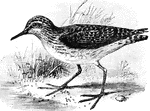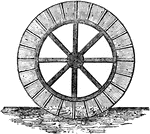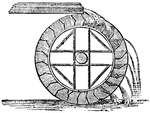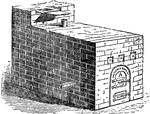
Gold Medal Boiler
"The Gold Medal Boiler is perhaps one of the best of these modified saddles, and like the others has…
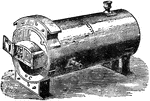
Trentham Boiler
"A very powerful and economical one, for large establishments especially. It is a modification of the…
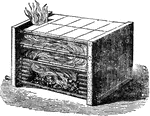
Ladds's Boiler
"A horizontal tubular, which is found to be extremely powerful as well as economical. It is a rectangular…
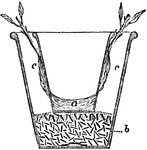
Cutting Pot
"A special contrivance for a cutting pot was brought into notice many years ago by Mr. A. Forsyth. A…

Pelargoniums
"Some plants, like pelargoniums, can only be kept handsomely formed and well furnished by cutting them…
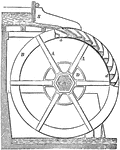
Water Wheel
"When a water fall ranges between 10 and 70 feet, and the water supply is from 3 to 25 cubic feet per…
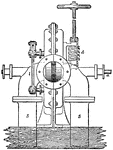
Reaction Turbine
"Professor James Thomson's inward flow or vortex turbine has been selected as the type of reaction turbines.…
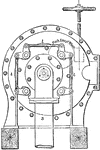
Reaction Turbine
"Professor James Thomson's inward flow or vortex turbine has been selected as the type of reaction turbines.…
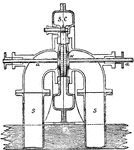
Reaction Turbine
"Professor James Thomson's inward flow or vortex turbine has been selected as the type of reaction turbines.…

Reaction Turbine
"Professor James Thomson's inward flow or vortex turbine has been selected as the type of reaction turbines.…
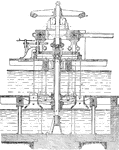
Girard Turbine
"The general sectionl elevation of a Girard turbine, in which the flow is axial. The water, admitted…
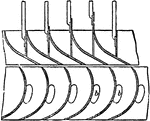
Guideblade Chamber
"The sectional form of the guideblade chamber and the wheel and the curves of the wheel vanes and guideblades,…
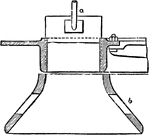
Guideblade Chamber
"The sectional form of the guideblade chamber and the wheel and the curves of the wheel vanes and guideblades,…

Centrifugal Pump
"A centrifugal pump differing from an ordinary centrifugal pumps in one feature only. The water rises…

Bulb Hygrometer
"This hygrometer consists of two thermometers a and b similar to each other in all respects except that…

Soda Water
"Carbonic acid water, generally spoken of as Sodawater, though it seldom contains any soda. It is prepared…

Soda Water
"Carbonic acid water, generally spoken of as Sodawater, though it seldom contains any soda. It is prepared…
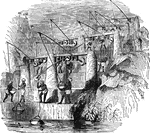
Shadoof
An irrigation tool invented by the people of ancient Sumer. It uses weights to make lifting buckets…

Animalcule
"A term etymologically applicable to any very small animal, and limited in actual use to those which…
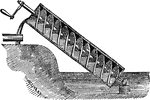
Archimedes Screw
"A machine for raising water, said to have been invented by Archimedes, during his stay in Egypt for…
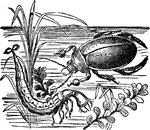
Great Diving Beetle
"A, Dytiscus Marginalis, or great Water-beetle; B, larva." — Chambers' Encyclopedia, 1875
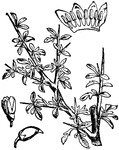
Myrrh
"Myrrh, is the name given to a gum resin which exudes from a shrub growing in Arabia and Abyssinia,…
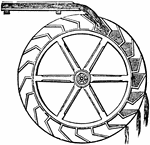
Water-wheel
"A wheel driven by water shot over the top. The buckets of the wheel receive the water as nearly as…

Oyster
"Anatomy of the Oyster. A. Hinge or anterior umbonal end of the left valve of an adult oyster, upon…

Langen's Collector
"Langens arrangement is a somewhat similar combination, the cone being made into a bell with perforated…
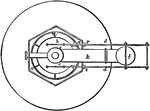
Langen's Collector
"Langens arrangement is a somewhat similar combination, the cone being made into a bell with perforated…
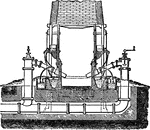
Refinery
"The term "refining," although in strictness applicable to all methods by which impure iron is purified,…

Refinery
"The term "refining," although in strictness applicable to all methods by which impure iron is purified,…
Centrifugal Force
"When a vessel containing water is whirled rapidly round, why does not the water fall out when the vessel…
Water Level
"a, a, a, represents the water-level of a pond or reservoir upon elevated ground. From this pond a line…
Gravel Hill
"Suppose a to be a gravel hill, and b a strata of clay or rock, impervious to water. The fluid percolating…

Sandy Stratum
"A sandy stratum, a a, acting as a filter, occupies an inclined position between two other strata impervious…

Pump
"The common pump consists of a hollow tube, the lower part of which, descending into the water, is called…

Forcing-Pump
"In the forcing-pump atmospheric pressure plays but a small part. There is no valve in the piston c,…

Chain-Pump
"The chain-pump consists of a tube or cylinder, the lower part of which is immersed in a well or reservoir,…

Retort
"A peculiar-shaped vessel called a retort is half filled with a volatile liquid and heated; the steam,…

Reflection
"Let S be the position of the spectator; O and B the position of distant objects. The rays O R and B…
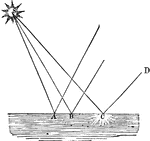
Reflection
"Here, of the rays S A, S B, and S C, only the ray S C meets the eye of the spectator D. The spot C,…

Refraction
"The following simple experiment illustrates the effect of refraction:—Place a silver coin, m,…
Egyptian Chain
"A gold chain is formed of wires closely plaited and very flexible, the ends terminating in the heads…
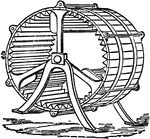
Dash Wheel
"Harness hides are washed by some means in pure water, the most convenient and generally adopted method…
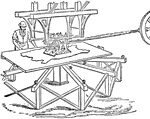
Scouring Machine
"Another machine now largely used by curriers is the scouring machine, a level table or platform freely…
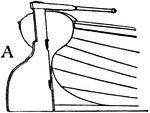
Rudder
The part of the helm which is abaft the stern post and is turned by the tiller so as to expose its side…
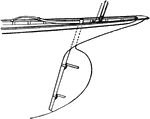
Rudder
The part of the helm which is abaft the stern post and is turned by the tiller so as to expose its side…

Rudder
The part of the helm which is abaft the stern post and is turned by the tiller so as to expose its side…
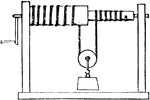
Windlass
"Windlass.—The common windlass for drawing water is another modification of the wheel and axle.…
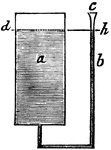
Water Pressure
"Suppose the cistern a to be capable of holding one hundred gallons, and into its bottom there be fitted…

Water Pressure
"Suppose a number of vessels, of different shapes and sizes to have a communication between them, by…

Hydraulic Bellows
"An instrument called the hydrostatic bellows, also shows, in a striking manner, the great force of…
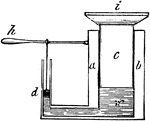
Hydraulic Press
"The pump barrel, a, b, is represented as divided lengthwise, in order to show the inside. The piston,…

Mountain Rupture
"Rupture of a Mountain.—There is no doubt, but in the operations of nature, great effects are…
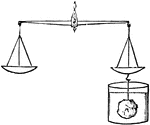
Water Weighing
"Take a piece of ivory, or any other substance that will sink in water, and weigh it accurately in the…

Intermitting Spring
"A mountain and spring, showing how the principle of the syphon operates to produce the effect described.…


